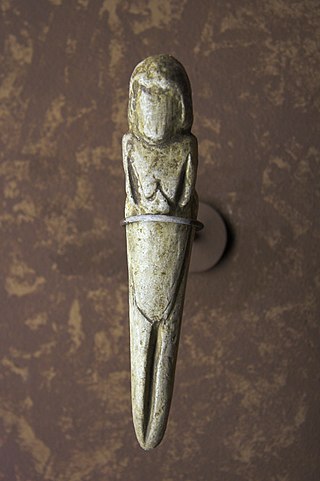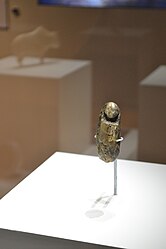
The Venus of Willendorf is an 11.1-centimetre-tall (4.4 in) Venus figurine estimated to have been made around 25,000–30,000 years ago. It was recovered on August 7, 1908 from an archaeological dig conducted by Josef Szombathy, Hugo Obermaier, and Josef Bayer at a Paleolithic site near Willendorf, a village in Lower Austria. The figurine was found by a workman named either Johann Veran or Josef Veram and is carved from an oolitic limestone that is not local to the area, and tinted with red ochre. It is now in the Natural History Museum in Vienna, Austria.

The Venus of Dolní Věstonice is a Venus figurine, a ceramic statuette of a nude female figure dated to 29,000–25,000 BCE. It was found at the Paleolithic site Dolní Věstonice in the Moravian basin south of Brno, in the base of Děvín Mountain in what is today the Czech Republic. This figurine and a few others from locations nearby are the oldest known ceramic articles in the world.

A Venus figurine is any Upper Palaeolithic statue portraying a woman, usually carved in the round. Most have been unearthed in Europe, but others have been found as far away as Siberia and distributed across much of Eurasia.

The Aurignacian is an archaeological industry of the Upper Paleolithic associated with Early European modern humans (EEMH) lasting from 43,000 to 26,000 years ago. The Upper Paleolithic developed in Europe some time after the Levant, where the Emiran period and the Ahmarian period form the first periods of the Upper Paleolithic, corresponding to the first stages of the expansion of Homo sapiens out of Africa. They then migrated to Europe and created the first European culture of modern humans, the Aurignacian.

The Gravettian was an archaeological industry of the European Upper Paleolithic that succeeded the Aurignacian circa 33,000 years BP. It is archaeologically the last European culture many consider unified, and had mostly disappeared by c. 22,000 BP, close to the Last Glacial Maximum, although some elements lasted until c. 17,000 BP. In Spain and France, it was succeeded by the Solutrean, and developed into or continued as the Epigravettian in Italy, the Balkans, Ukraine and Russia.

Zaraysk is a town and the administrative center of Zaraysky District in Moscow Oblast, Russia, located about 162 kilometers (101 mi) southeast from Moscow. Population: 24,645 (2010 Census); 25,093 (2002 Census); 26,958 (1989 Census).

The Venus of Brassempouy is a fragmentary ivory figurine from the Upper Palaeolithic, apparently broken from a larger figure at some time unknown. It was discovered in a cave at Brassempouy, France in 1894. About 25,000 years old, it is one of the earliest known realistic representations of a human face.

The Löwenmensch figurine, also called the Lion-man of Hohlenstein-Stadel, is a prehistoric ivory sculpture discovered in Hohlenstein-Stadel, a German cave, in 1939. The German name, Löwenmensch, meaning "lion-person" or "lion-human", is used most frequently because it was discovered and is exhibited in Germany.

The Venus of Hohle Fels is an Upper Paleolithic Venus figurine made of mammoth ivory that was unearthed in 2008 in Hohle Fels, a cave near Schelklingen, Germany. It is dated to between 40,000 and 35,000 years ago, belonging to the early Aurignacian, at the very beginning of the Upper Paleolithic, which is associated with the earliest presence of Cro-Magnon in Europe.

The Hohle Fels is a cave in the Swabian Jura of Germany that has yielded a number of important archaeological finds dating from the Upper Paleolithic. Artifacts found in the cave represent some of the earliest examples of prehistoric art and musical instruments ever discovered. The cave is just outside the town of Schelklingen in the state of Baden-Württemberg, near Ulm. Because of the outstanding archeological finds and their cultural significance, in 2017 the site became part of the UNESCO World Heritage Site Caves and Ice Age Art in the Swabian Jura.

The art of the Upper Paleolithic represents the oldest form of prehistoric art. Figurative art is present in Europe and Southeast Asia, beginning between about 40,000 to 35,000 years ago. Non-figurative cave paintings, consisting of hand stencils and simple geometric shapes, are somewhat older, at least 40,000 years old, and possibly as old as 64,000 years. This latter estimate is due to a controversial 2018 study based on uranium-thorium dating, which would imply Neanderthal authorship and qualify as art of the Middle Paleolithic.

The Mal'ta–Buret' culture is an archaeological culture of the Upper Paleolithic. It is located roughly northwest of Lake Baikal, about 90km to the northwest of Irkutsk, on the banks of the upper Angara River.

Cro-Magnons or European early modern humans (EEMH) were the first early modern humans to settle in Europe, migrating from western Asia, continuously occupying the continent possibly from as early as 56,800 years ago. They interacted and interbred with the indigenous Neanderthals of Europe and Western Asia, who went extinct 40,000 to 35,000 years ago. The first wave of modern humans in Europe left no genetic legacy to modern Europeans; however, from 37,000 years ago a second wave succeeded in forming a single founder population, from which all subsequent Cro-Magnons descended and which contributes ancestry to present-day Europeans. Cro-Magnons produced Upper Palaeolithic cultures, the first major one being the Aurignacian, which was succeeded by the Gravettian by 30,000 years ago. The Gravettian split into the Epi-Gravettian in the east and Solutrean in the west, due to major climatic degradation during the Last Glacial Maximum (LGM), peaking 21,000 years ago. As Europe warmed, the Solutrean evolved into the Magdalenian by 20,000 years ago, and these peoples recolonised Europe. The Magdalenian and Epi-Gravettian gave way to Mesolithic cultures as big game animals were dying out and the Last Glacial Period drew to a close.

The Swimming Reindeer is a 13,000-year-old Magdalenian sculpture of two swimming reindeer conserved in the British Museum. The sculpture was made in what is now modern-day France by an unknown sculptor who carved the artwork from the tip of a mammoth tusk. The sculpture was found in two pieces in 1866, but it was not until 1904 that Abbé Henri Breuil realised that the two pieces fit together to form a single artwork of two reindeer swimming nose-to-tail.

The Venus figurines of Mal’ta are several palaeolithic female figurines of the Mal'ta–Buret' culture, found in Siberia, Russia.

The Montastruc decorated stone is an example of Ice Age art, now in the British Museum. A human figure that appears to be female has been scratched or engraved to decorate a fragment of limestone used as a lamp. The piece was excavated from Courbet Cave, Penne, Tarn, Midi-Pyrénées, France, on the northern bank of the river Aveyron, a tributary of the Tarn. It is dated to around 11,000 BCE, locally the Late Magdalenian culture during the Upper Palaeolithic, towards the end of the last Ice Age. It was excavated by Edouard Lartet and Henry Christy in 1863, and among other items bequeathed to Christie's museum.

The Venus of Petřkovice is a pre-historic Venus figurine, a mineral statuette of a nude female figure, dated to about 23,000 BCE in what is today the Czech Republic.

The Venus figurines of Gagarino are eight Palaeolithic Venus figurines made from ivory. The statuettes belong to the Gravettian industry and are about 21,000–20,000 years old. They were discovered near to the village of Gagarino in Lipetsk Oblast, Russia, and are now held in the Hermitage Museum in Saint Petersburg.

Jill Cook, is a British museum curator who is the acting Keeper of the Department of Britain, Europe and Prehistory at the British Museum. She curates the collection of European Prehistory and is a specialist in Ice Age art and the archaeology of human evolution.




















